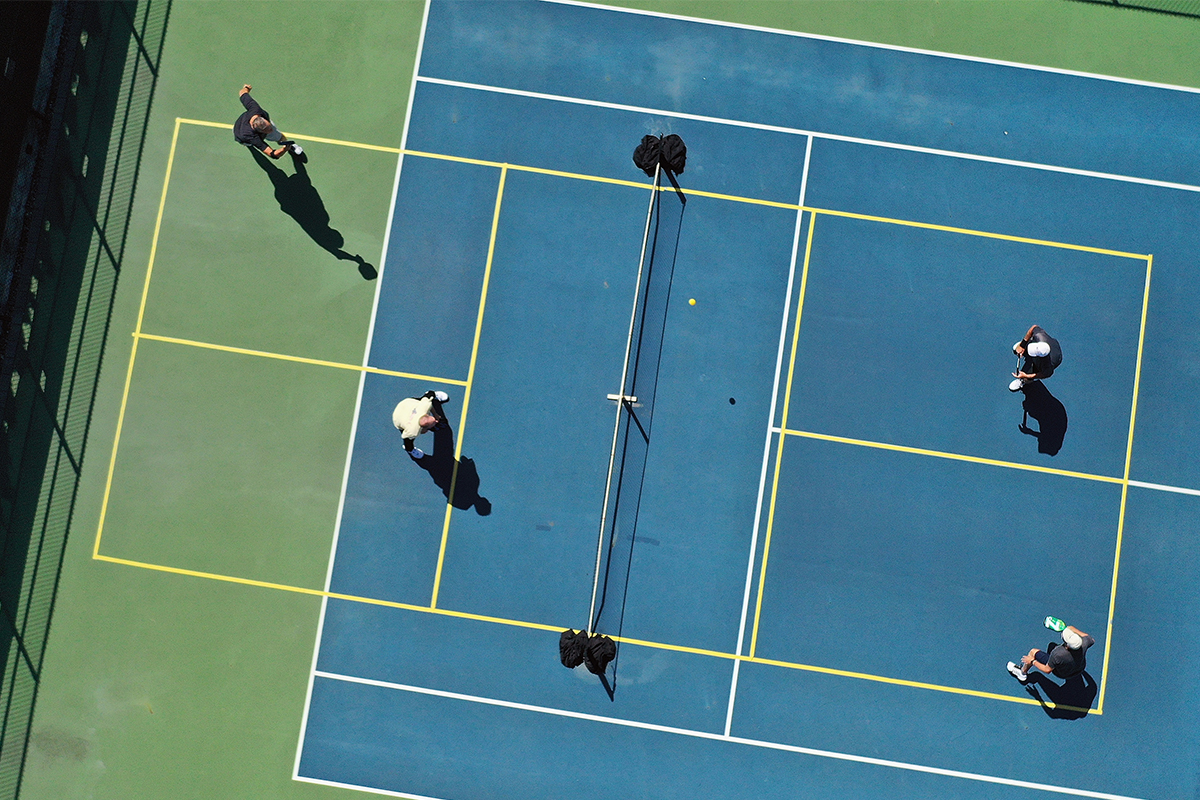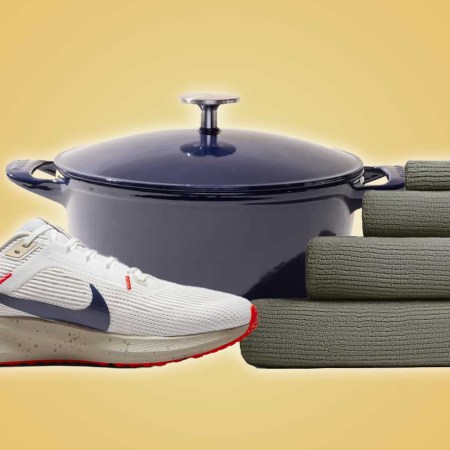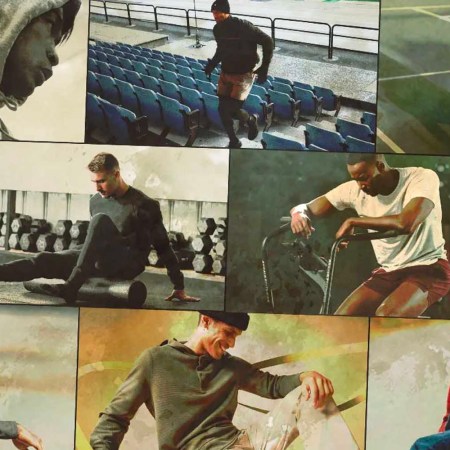Even by The New York Post‘s standards, a story the paper ran back in July of this year was over-the-top absurd. The headline read, verbatim: “Noise pollution of senior citizens playing pickleball has suburb outraged.”
That’s right — a troupe of pickleball-loving septuagenarians has apparently been terrorizing a town in Northern New Jersey, playing their beloved new hobby with such ferocity that one court-side neighbor says you’d need “hurricane force” windows to drown out the sound. Another compared the endless pop-pop-pop to the spray of an AK-47.
Still, the budding pickleball community doesn’t mean any harm. Most of the regulars started playing four times a week during the pandemic, as a way to stay in touch with friends and get outside. As one player told the Post: “Pickleball is a gift to us. We have made the nicest friends. We just laugh and have fun.”
These players weathered a series of punitive measures — strict hours of play, four months of court shutdown as the town hired a “sound specialist,” and at one point, even on-site security guards, who were there to make sure players were using noise-reducing equipment. But in a triumphant turn, the most aggrieved nearby residents literally moved away.
It’s a silly tale, and one that’s hopefully in development at Netflix as we speak, but it does offer two important takeaways. First, the importance of play as we age. From a longevity perspective, that combination of exercise, camaraderie and the outdoors is invaluable No wonder the picklers fought so hard for their fledgling hobby. They understood how good it was making them feel — physically, mentally, emotionally.
Second, though: the meteoric rise of pickleball as a sport. The neighborhood was so caught off guard because that complex used to house cracked, abandoned tennis courts. But the town put in pickleball courts, staking its claim on a trend that’s sweeping the entire the nation. Pickleball, believe it or not, is currently the fastest-growing sport in America.
The number of active players has jumped from around 500,000 five years ago to 2.5 million today. Portable pickleball nets briefly sold out during quarantine. Top tennis brands like Wilson and Prince now sell paddles in the $120 range. And there’s even a pickleball lifestyle magazine.
As recreation departments throughout the country continue to add courts, pickleball is likely to grow even more popular. This is one sport that doesn’t need to become an Olympic one for people to start caring about it — it’s found success because of its all-ages, mixed-group accessibility. The court’s on the smaller side, and gameplay is self-explanatory, making it a welcome alternative for those who are too intimidated (or too weak in the knees) to play tennis.
There are other new-age sports that made massive gains throughout the nation in 2021. Their respective ascents might be a little quieter than pickleball (in more ways than one), but they’re likely going to stick around for a while. Learning how to play them, meanwhile, could help you stick around for a while. From carveboarding to padel to something called teqball, we’ve compiled a brief guide to the most popular games and pursuits you’ve never heard of.
Windfoiling
You’ve likely seen a hydrofoil at the beach at some point over the last 20 years. Traditional hydrofoiling was pioneerd in part by Laird Hamilton, who pointed out just how “rideable” even mediocre waves became when the board is raised out of the water. (It essentially removes friction from the equation.) Now propeller-powered hydrofoil boards are having a moment; leading the way is The Lift eFoil, an electric hydrofoil surfboard. Sometimes, the motorized boards can seem sort of lame (Mark Zuckerberg using one on Lake Tahoe), but other times (in the case of a a father and son crossing the English Channel) they’re pretty hard to argue with.
Recently, interest in hydrofoils has coincided with the “death” of windsurfing, which won’t be on the 2024 Olympics lineup. Windsurfing fell out, some experts reckon, as newer crazes emerged in the late ’90s and early 2000’s, namely kitesurfing and standup paddle boarding. But the latest water-sport obsession seems determined to resurrect windsurfing, and rebrand it as “windfoiling.” It’s windsurfing with a hydrofoil board, basically, and it’s to be the latest Olympic discipline. Fans of the activity appreciate how effortlessly the sail glides on light winds. With old-school windsurfing equipment you needed wind at 15-20 knots. With a hydrofoil board, just eight knots could do.
Teqball
The brains behind this insane game like to say “the world is curved.” Teqball is basically soccer meets spikeball meets table tennis. Invented by a former Hungarian footballer and a computer scientist, the idea was to make a table that would allow competitors to play “table tennis” with a soccer ball. They created a prototype table with curved edges, realizing it helped the ball bounce easier towards the foot. There is now an annual Teqball World Championships, with 20 participating nations, and a plan to include the game in the next European Games (slated for 2023).
How is it played? This is a dream game for skilled soccer players who just missed making the pros. Each side gets three touches to return the ball; you cannot use any body part twice in a row. Feet, head and chest are all in play. Sets are to 12 points. If Teqball’s rich library of online content is any indication, this game is best enjoyed when played as doubles. (In doubles, the same “three touches” rule applies.) You actually can buy a Teqball Table online, just be warned that it costs about $2,000. A table-less version of this game could probably be played at your local pickleball court, though, funnily enough.
Padel
Another riff on tennis, which seems to be a theme here. The people want their racket sports. Padel has seen an increase in internet impressions of over 175% over the last five years, as the sport has spread from its native home of Mexico (it was invented in the late ’60s) across the pond to Europe — where it’s massively popular in Spain — and finally up to America. The USTA National Tennis Campus got four new courts in June of this year, and plans to start rolling out sanctioned tournaments.
If you squint, padel looks a lot like pickleball, but there are some key differences. Padel players use depressurized rubber balls (they’re bigger than a golf ball, smaller than a standard tennis ball) and play on slightly longer courts than picklers — although each court is tiny compared to a tennis court. The sport also varies from paddle tennis, a sort of mini-tennis that has long been popular in America and Canada, in that it’s played within an enclosed space. There are four walls, usually made from perforated foam, which are fully in play. Players bounce the ball off the walls in an effort to earn points. And in an extremely entertaining twist, the space outside the walls is in play too. If the ball trickles out through a side door, players can run out, retrieve it in motion and send it back to the opposite side. See it for yourself on the first point here.
Carveboarding
This is what happens when a pair of California surfer/snowboard bums can’t get on the waves or slopes as often as they’d like. Carveboarding, also known as surfskating, involves ripping on an oversized longboard with the capacity to tilt up to 45 degrees. The board — with its rotating trucks and oversized tires — allows the rider to take turns at top speeds and carve up cement roads in a way that feels shockingly similar to the sensation of surfing or snowboarding. During the peak of pandemic, similar to hockey players buying up rollerskates, tons of stoke athletes bought out whatever carveboards they could find.
The sport is far less “official” at this point, compared to others on this list. There aren’t international competitions, and even finding a board (or one that doesn’t cost hundreds) can be a hassle. But it’s a much-appreciated, off-books avocation for now, for those who can’t get through a day without chasing some sort of thrill. This would seem to apply especially to the Brazilian surfing community, which happily posts videos online of caveboarding sessions throughout the streets. We personally recommend brushing up on your longboarding skills before taking the plunge into carveboarding, but when you do get after it, have fun out there. It’s one hell of a ride.
Whether you’re looking to get into shape, or just get out of a funk, The Charge has got you covered. Sign up for our new wellness newsletter today.
























